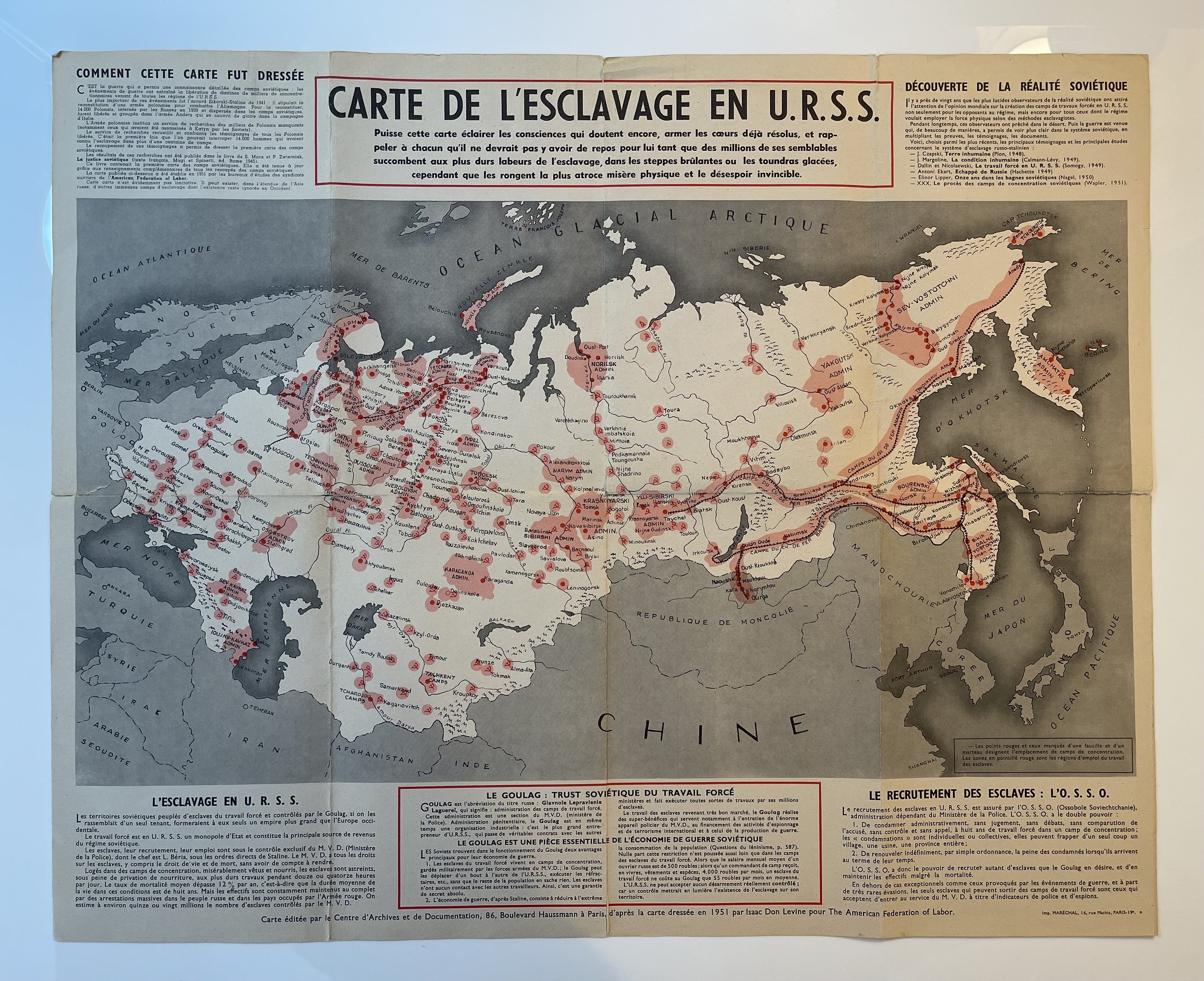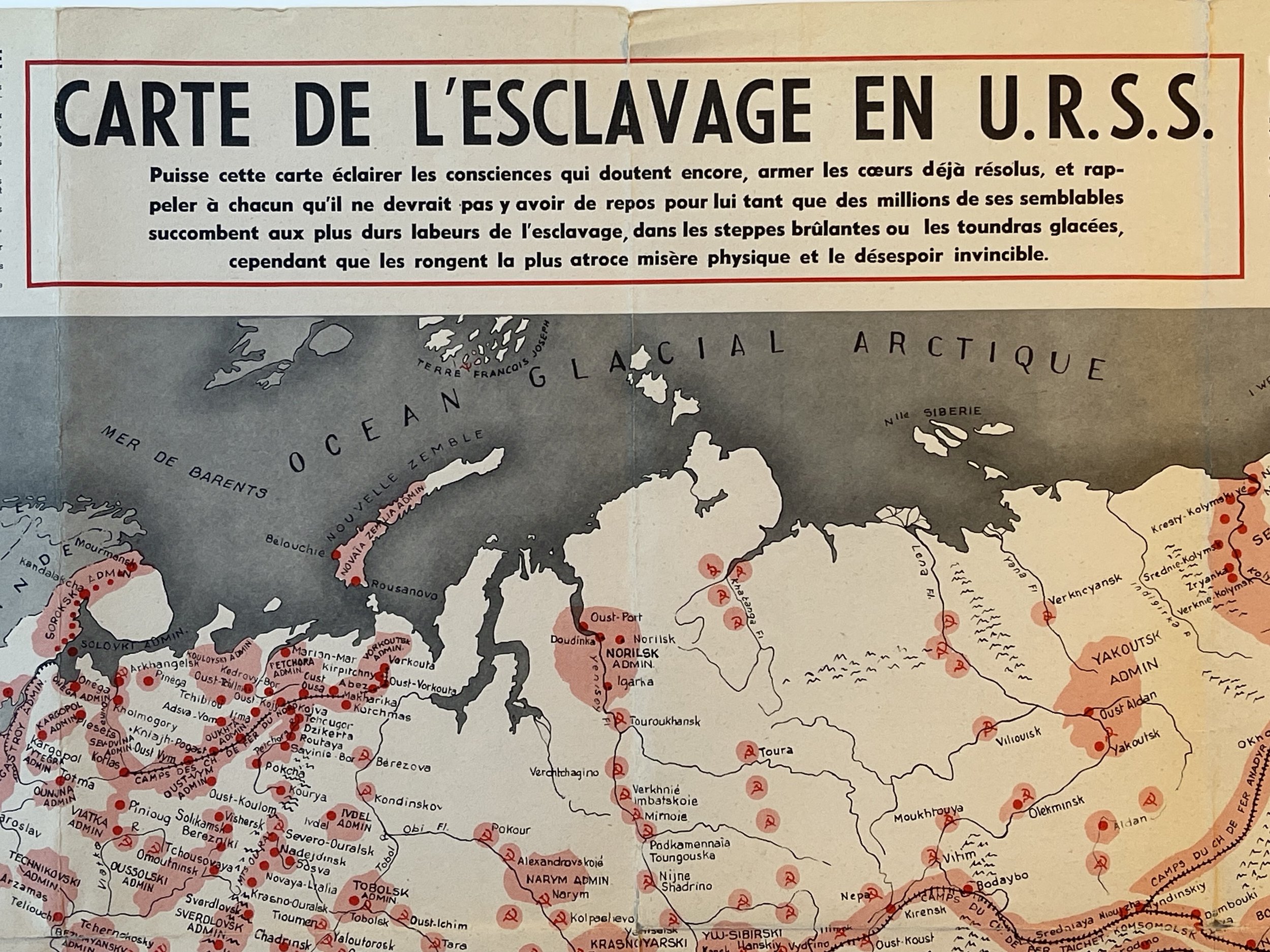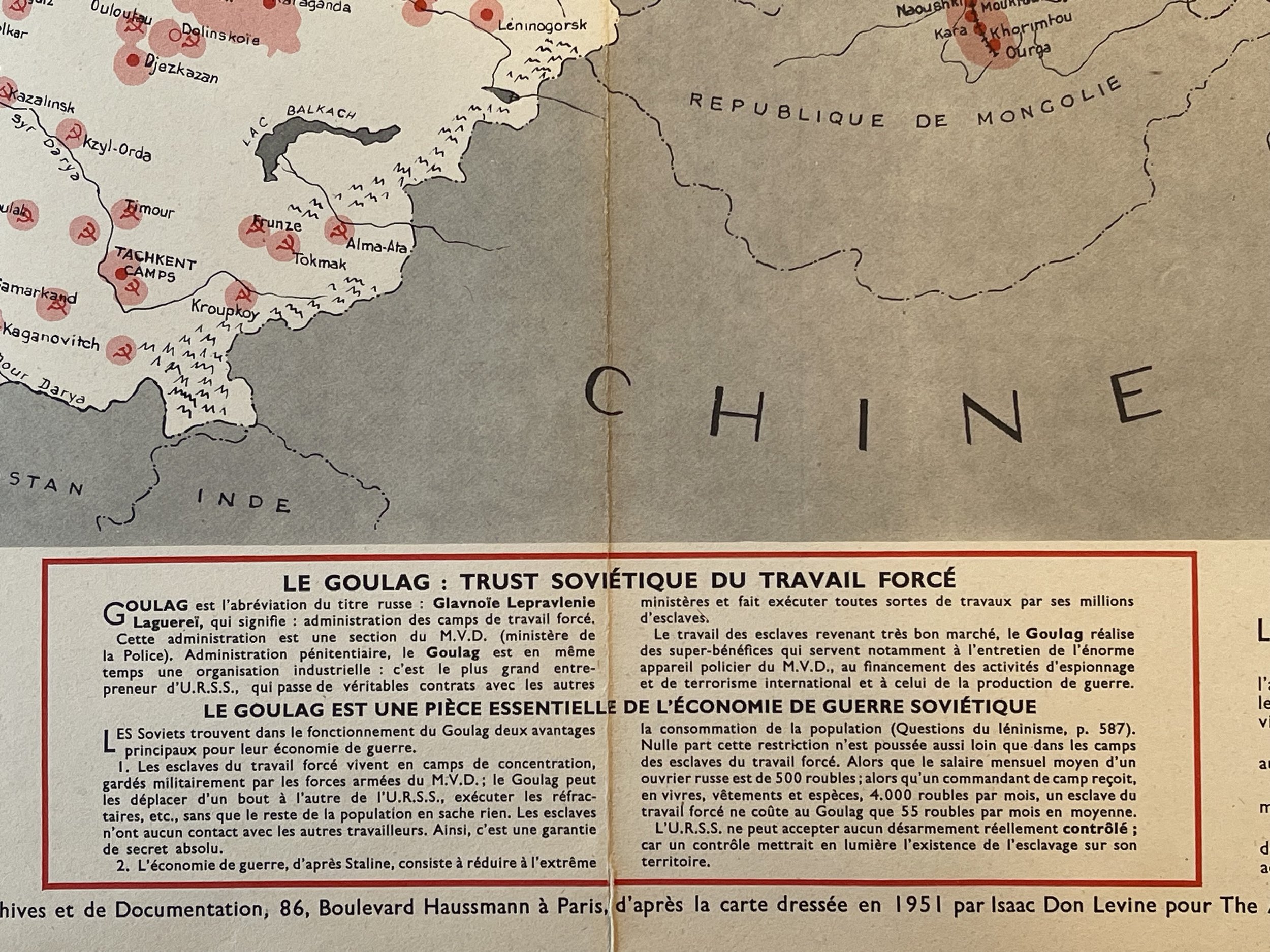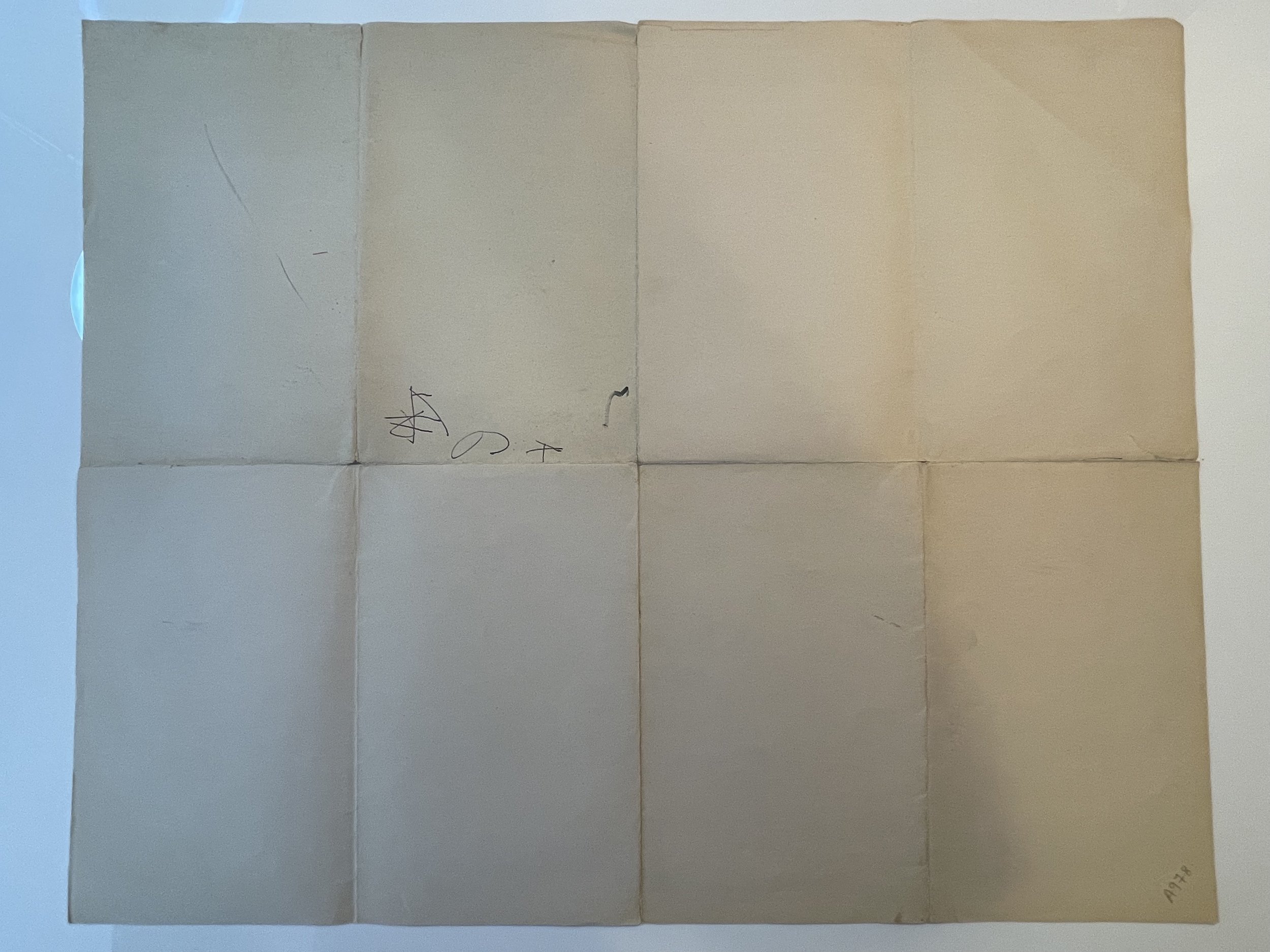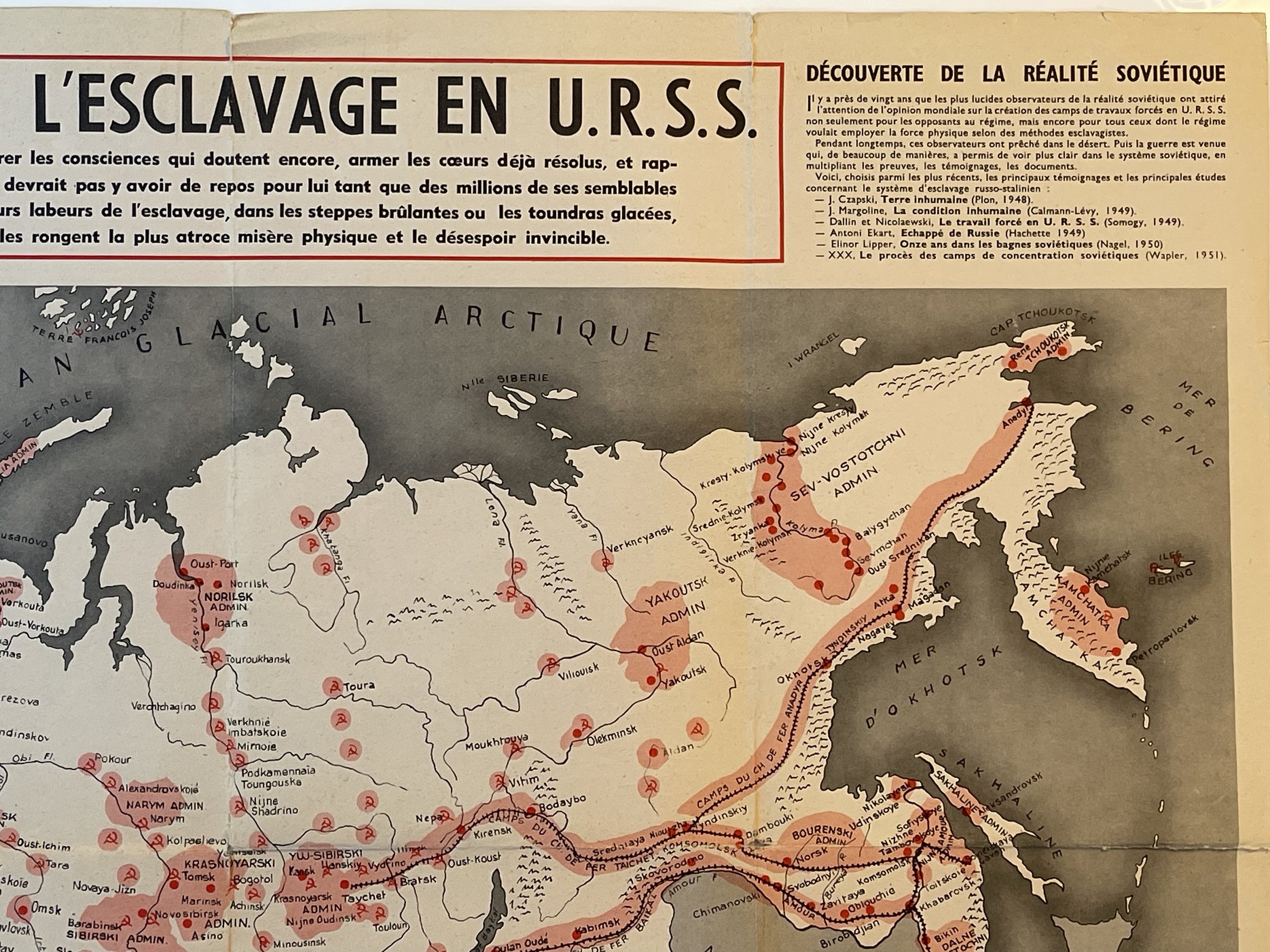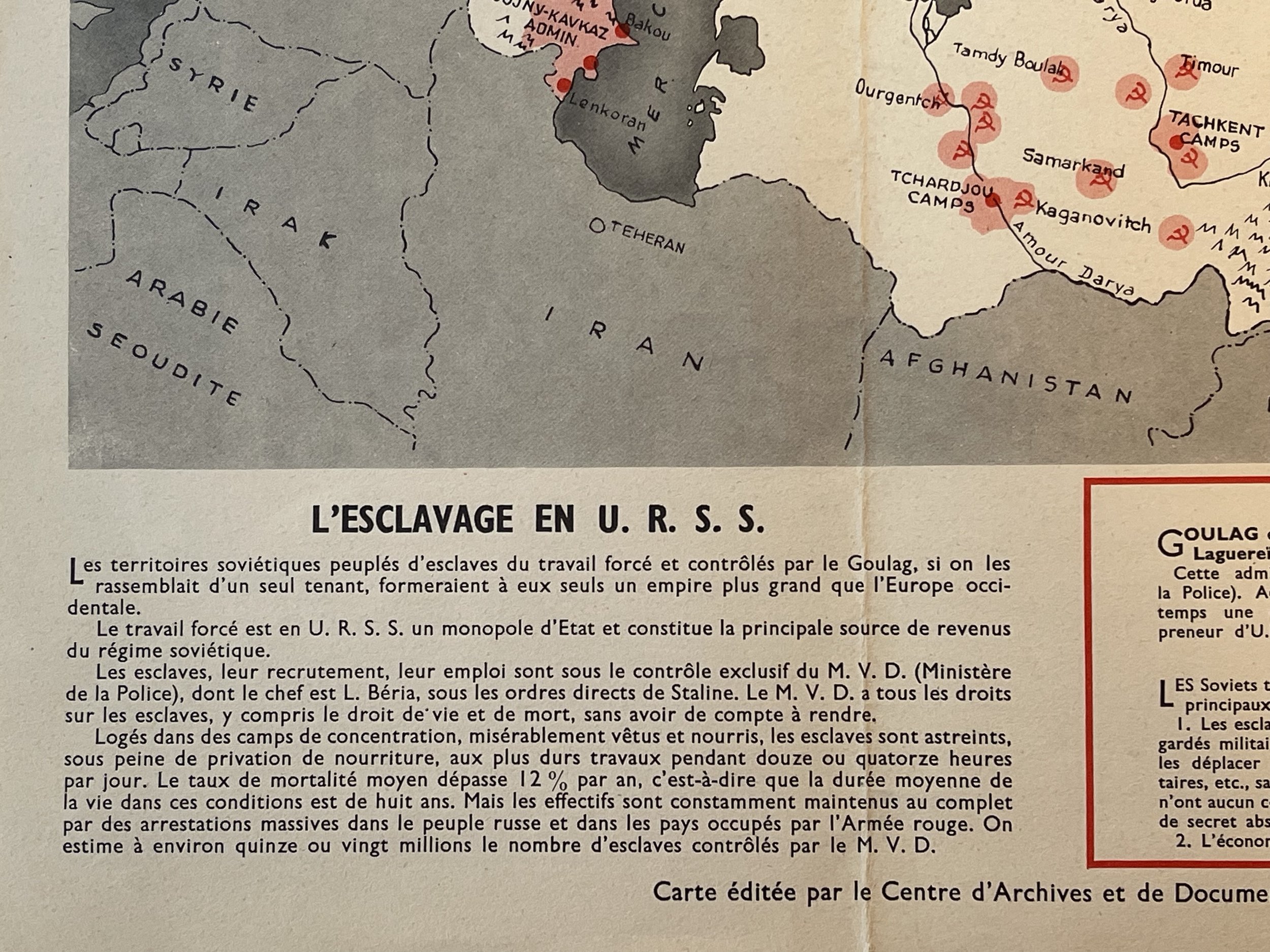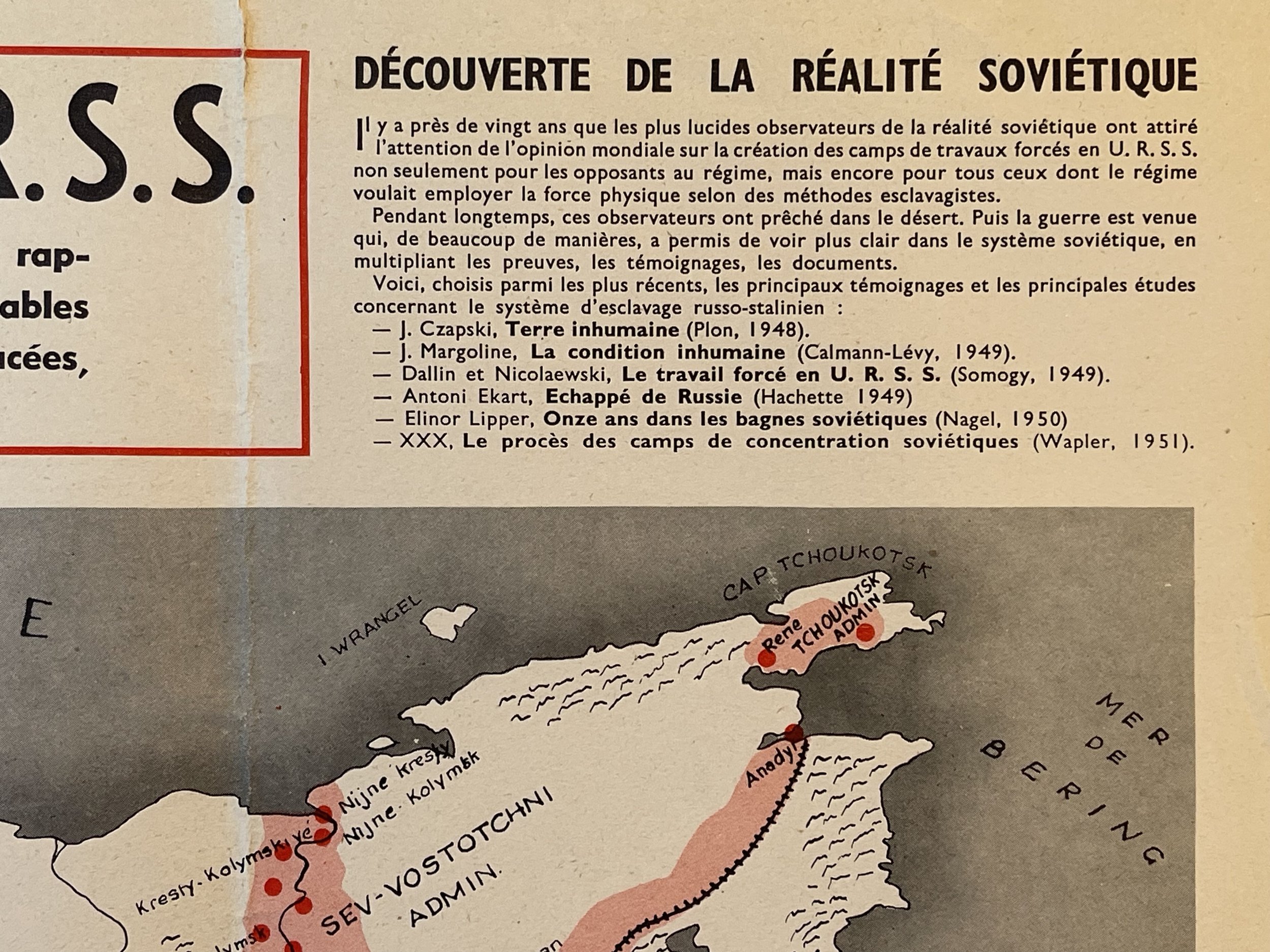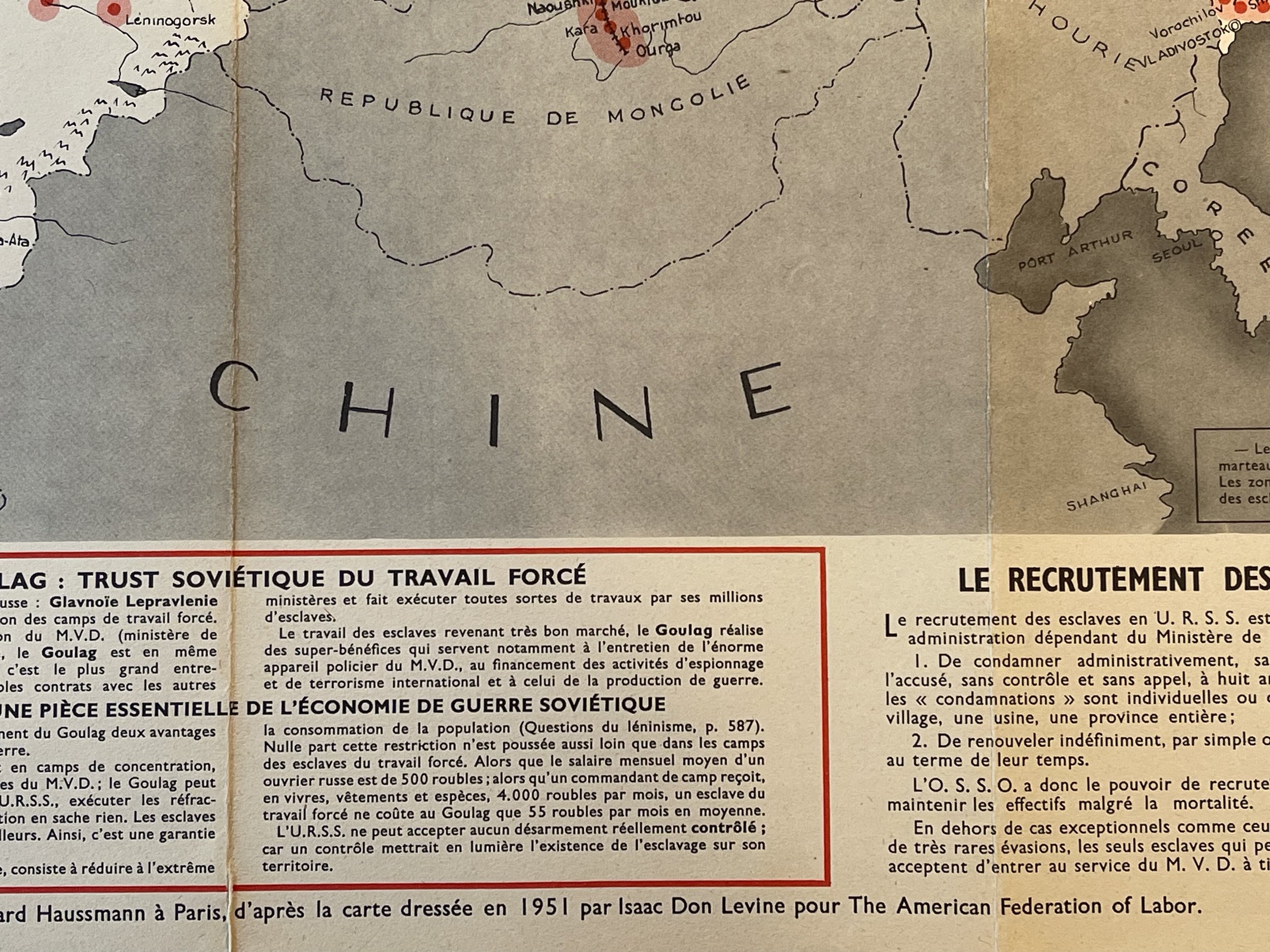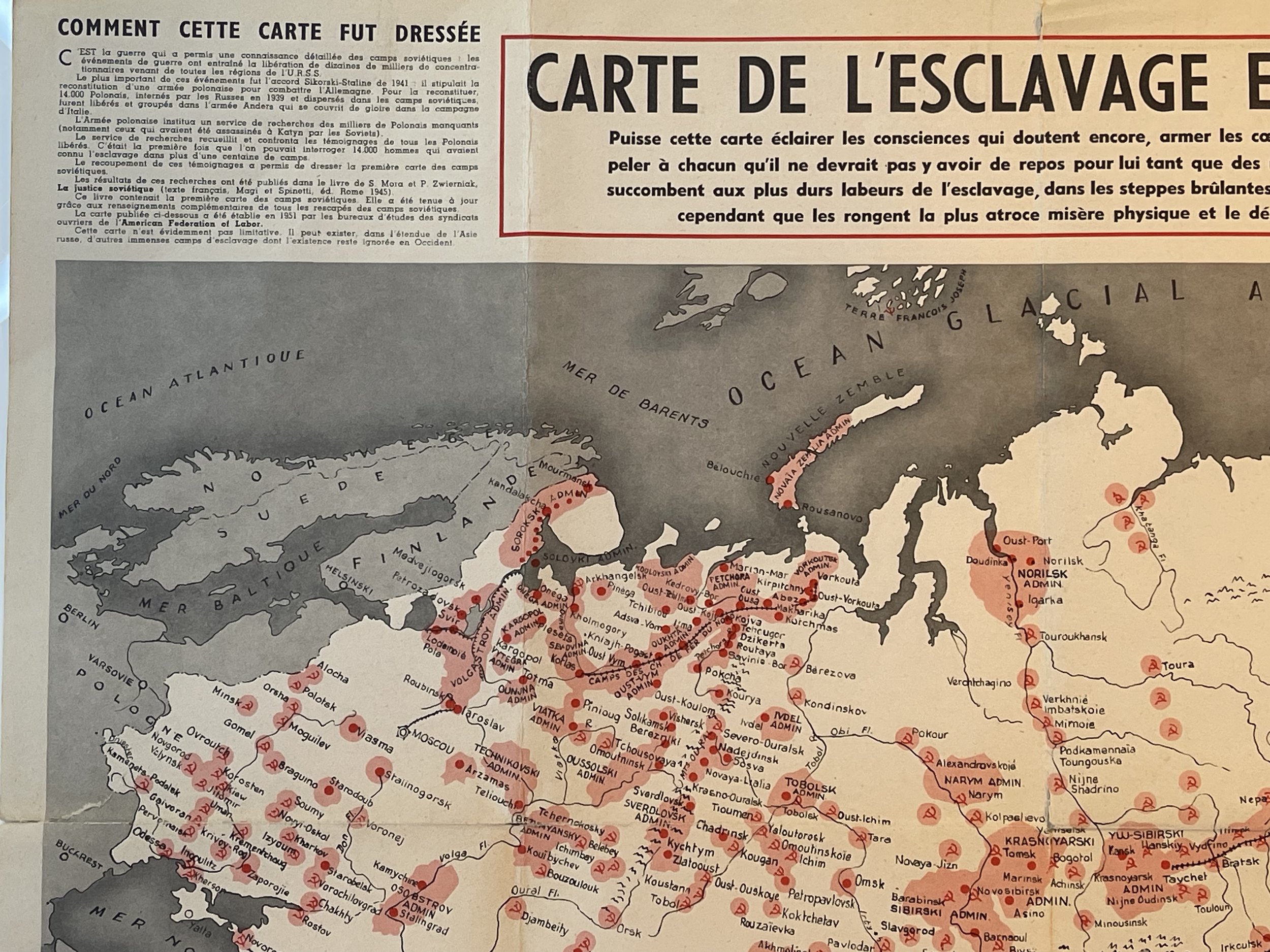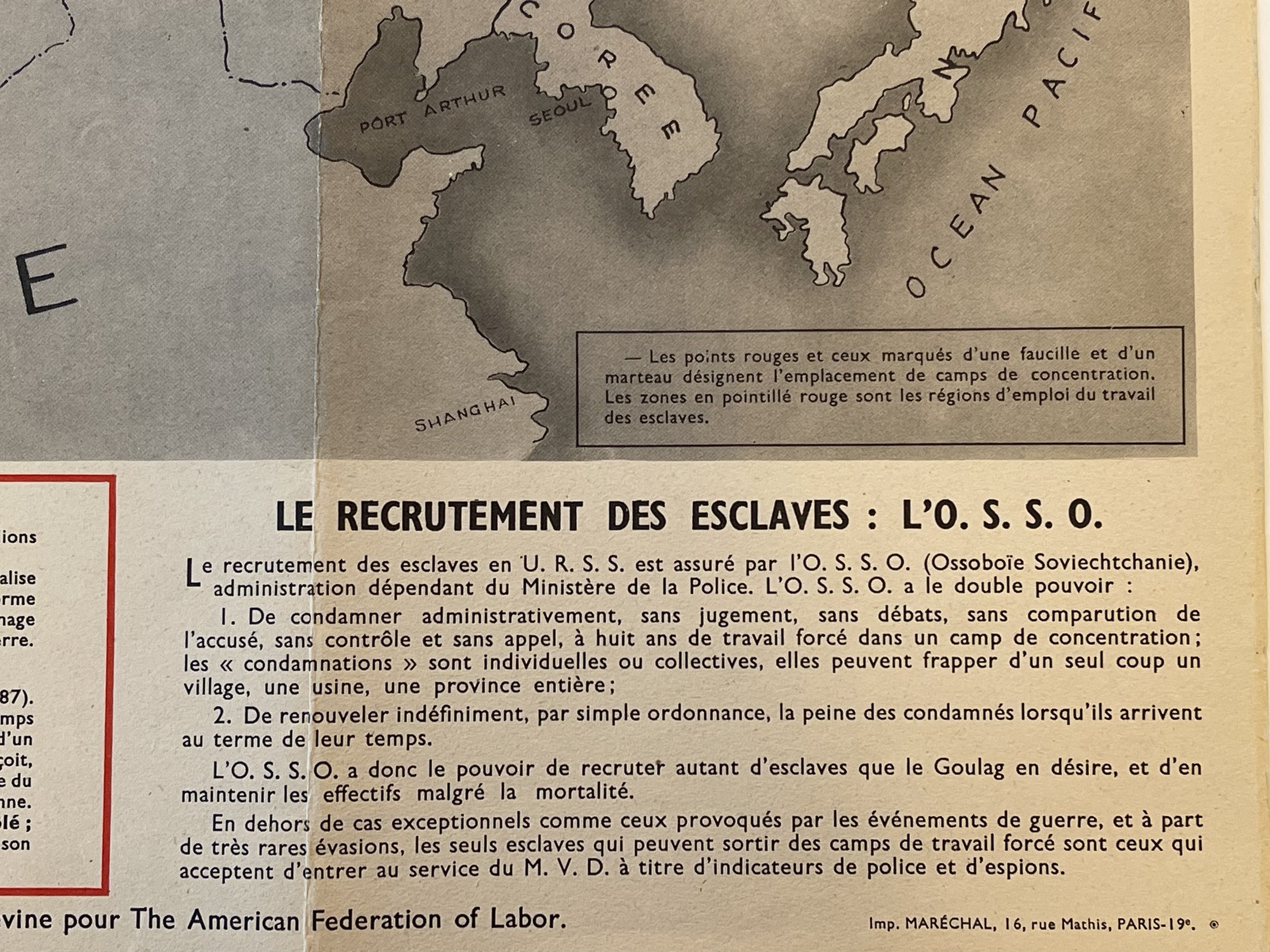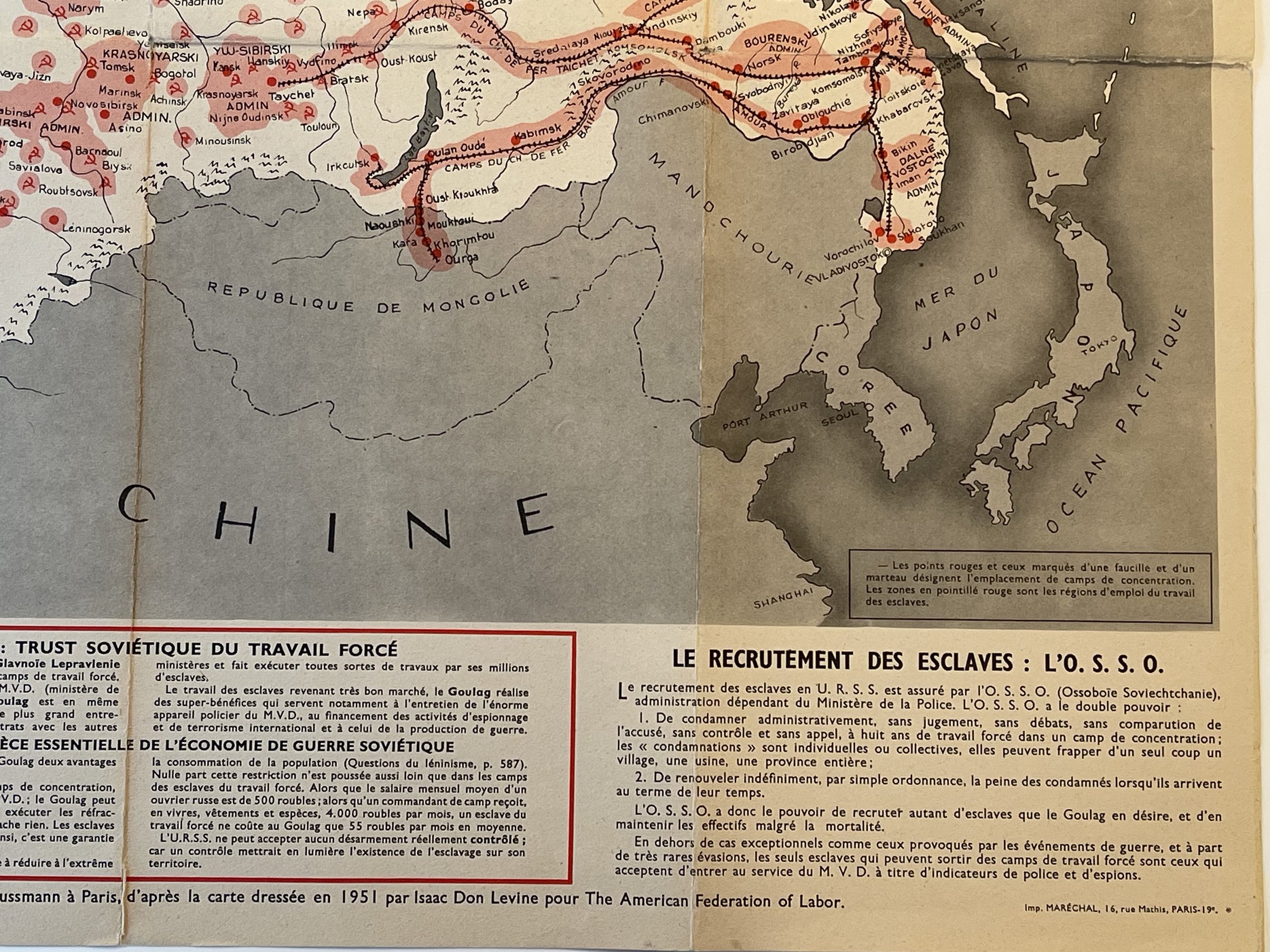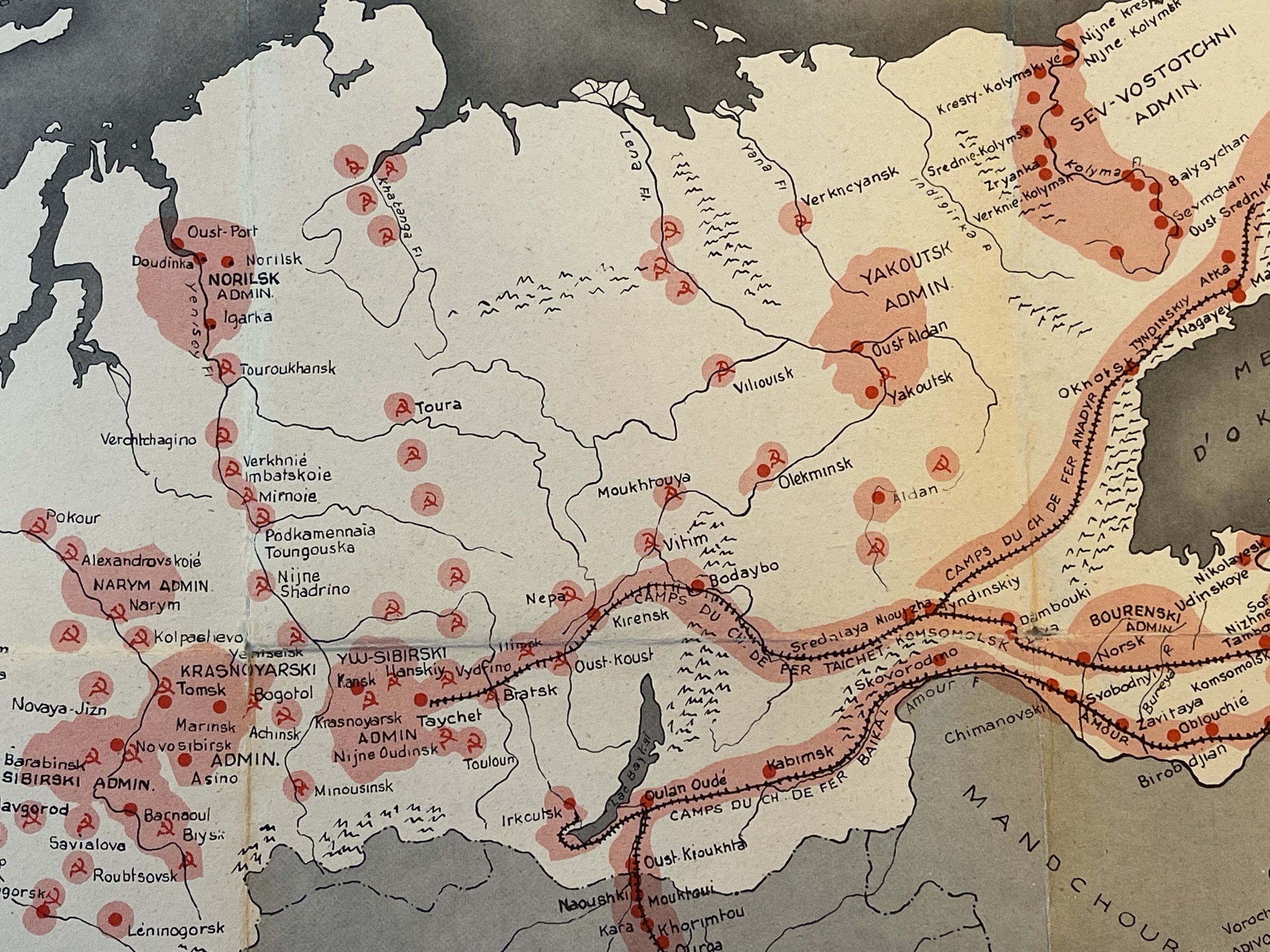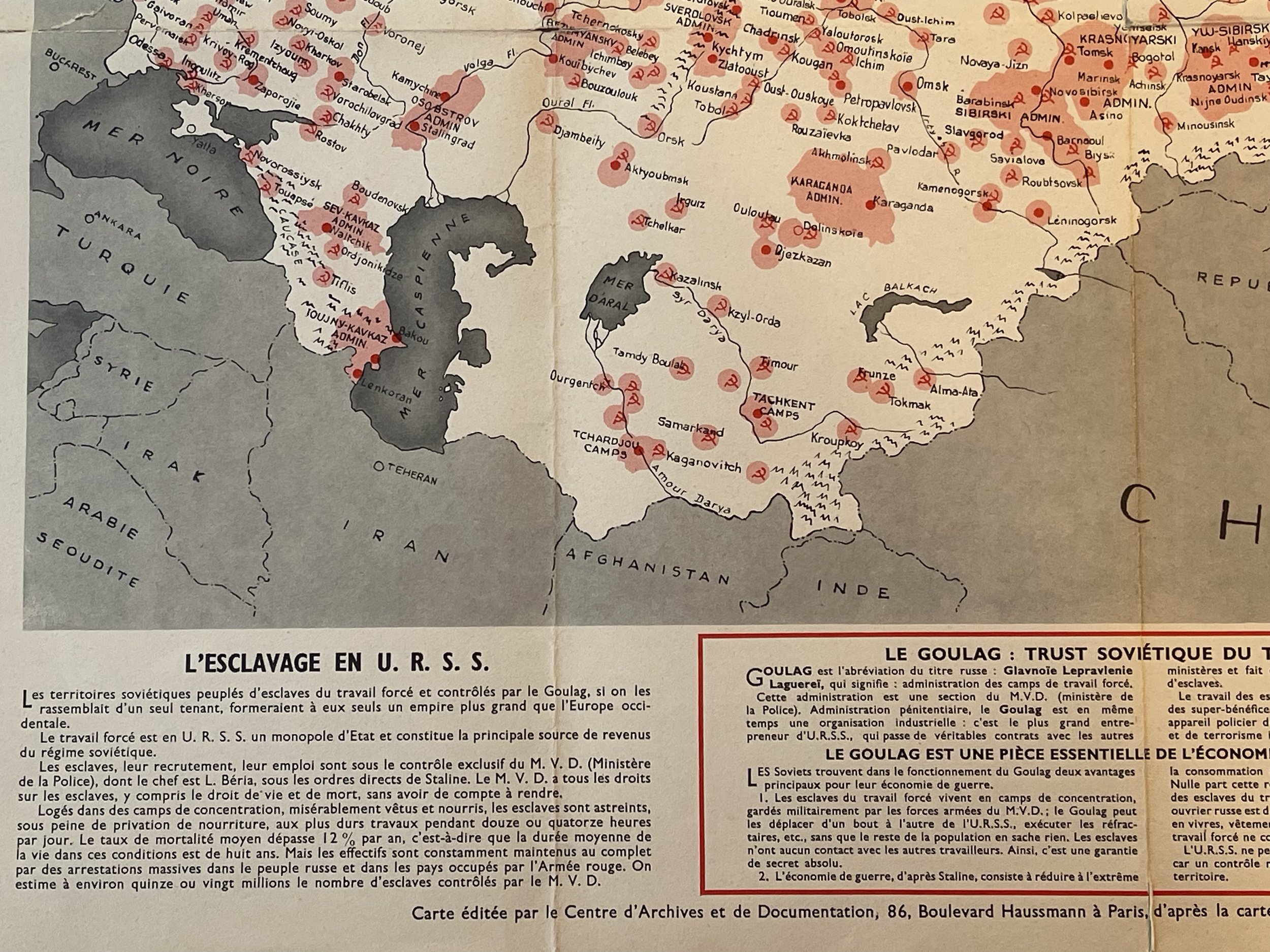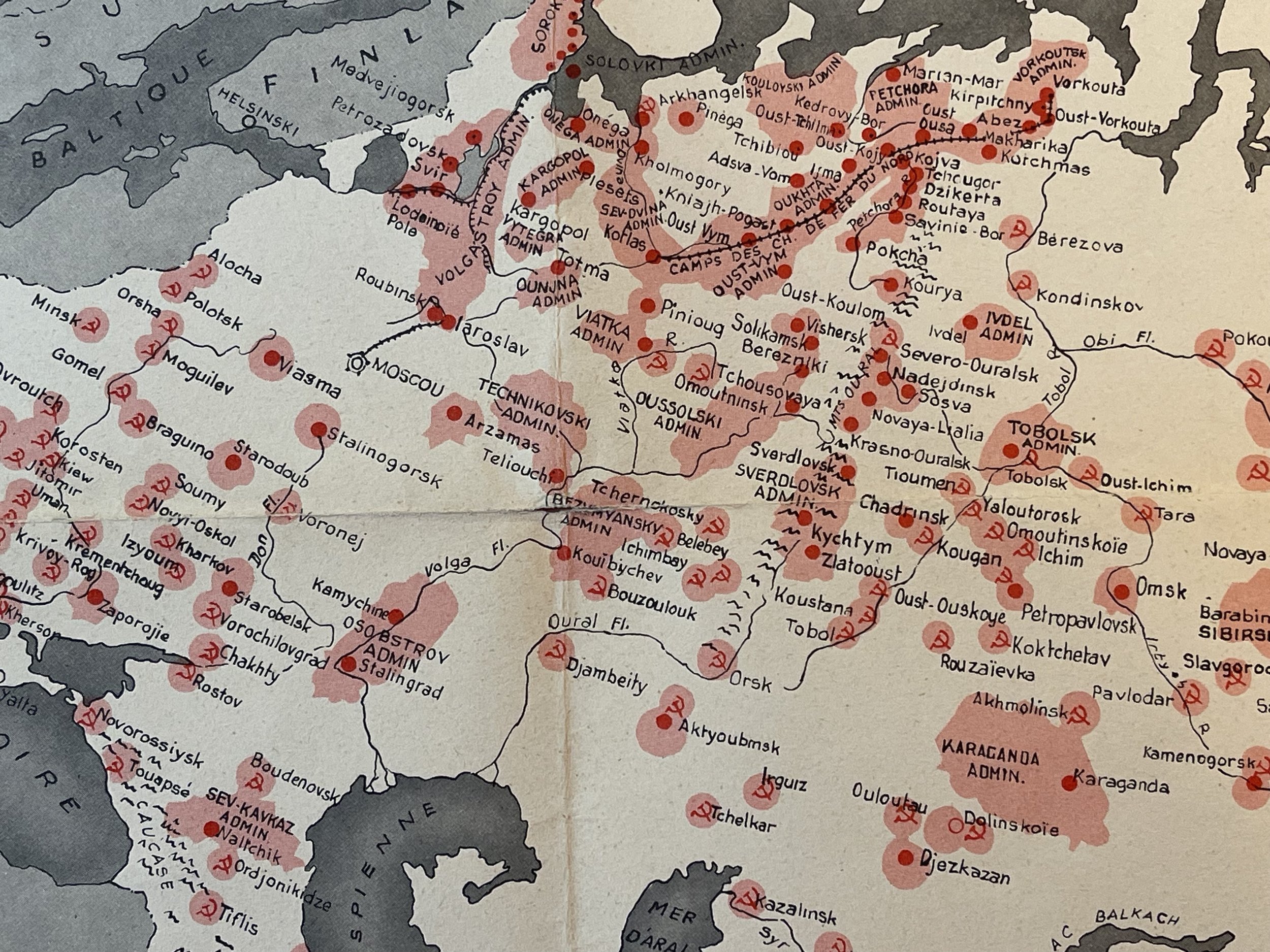Carte De L'Esclavage en U.R.S.S - Russian Gulags Cold War - Marechal. Isaac Don Levine - 1951/52 - RARE
Isaac Don Levine, CARTE DE L’ESCLAVAGE EN U.R.S.S. Paris: Centre d’Archives et de Documentation, 1951/1952
French-language anti-Communist map documenting the extent of the Soviet gulag system. Two-colour halftone, sheet size 17 1/2”h x 21 7/8”w. A bit of wear along old folds, else excellent.
A powerful persuasive map produced during the Cold War to document, though likely with some exaggeration, the extent of the Soviet Gulag system. The Gulag was created almost immediately after the Russian Revolution, taking its name from an acronym of the Russian phrase for “Chief Administration of Corrective Labor Camps.” Though estimates of its scale differ, it grew to include hundreds of camps housing millions of criminals, political prisoners, and prisoners of war.
After the Second World War, the size and brutality of the Gulag provided much ammunition for the propaganda efforts of Cold Warriors in America and abroad. Offered here is a striking example, being a rare thematic map depicting the distribution of forced labour camps in the Soviet Union. It features a central map of the country, projected in a manner that exaggerates its east-west extent and, by implication, the extent of the Gulag. Areas occupied by camps are named and highlighted in red, with those under local control indicated by a hammer and sickle and those under centralised control by a small circle. The map is surrounded by columns of text describing the brutality of the Gulag and its central role in the Soviet system.
The map can be traced to one in Sprawiedliwość Sowiecka (Rome, 1945), an expose by Polish officers Sylvester Mora and Pierre Zwierniak. That work was an early attempt to describe the Soviet gulag system, of particular interest for its use of prisoners’ first-hand accounts and attempts to quantify the use of slave labour. The map first appeared in America when Isaac Don Levine, editor of the anti-Communist magazine Plain Talk, included a revised, English-language version of the map in the May 1947 issue.
According to P.J. Mode, “The publication of the Plain Talk map gained some prominent press coverage and led the American Federation of Labor (AFL) to make a formal proposal that UNESCO conduct an international investigation of forced labour.” When the proposal went nowhere, the AFL undertook a propaganda campaign through its Free Trade Union Committee, a CIA front organisation. The Committee commissioned Don Levine to publish an updated version of his map, which duly appeared in 1951. It was widely distributed, and arrangements were made to publish European versions in French, German, Italian and possibly other languages.
This is a French edition of Isaac Don Levine's Gulag map, which became an icon of the anti-Communist movement during the Cold War. Gulag is an acronym for the Soviet institution in charge of a network of forced labour camps that were created under the leadership of Vladimir Lenin after the 1918 revolution. The camps operated at their peak under Joseph Stalin's rule between 1930-50 and were promoted in anti-Communist propaganda as a symbol of one of the fundamental flaws of Communism. The first edition of Levine's Gulag map, "Gulag" - Slavery, Inc., appeared in the May 1947 issue of Plain Talk magazine, a monthly anti-Communist American publication for which Levine was the Editor-in-Chief. The map gained significant press coverage and prompted the American Federation of Labor (AFL) to urge the United Nations Economic and Social Council (UNESCO) to investigate of forced labour. After seeing no significant movement from UNESCO, the AFL decided to push their agenda through other avenues to garner both domestic and international attention. Working in coordination with the Free Trade Union Committee (FTUC), a secret CIA operative, the AFL requested Levine to update his map using new evidence that had surfaced regarding the locations and operations of the camps. The new map appeared in 1951 in several languages and editions, including one that was published in Time Magazine.The map shows the locations of the labor camps with red dots indicating those under centralized control and the hammer and sickle symbol indicating those under local control. The red shading represents the areas in which the laborers worked, including along several rail lines. The text surrounding the map explains the sources for the map, a list of literature on the Soviet forced-labor camp system, the brutal conditions within the camps, and the arbitrary Soviet method of recruitment of slaves as young as 8 years old. This French edition was edited by the Centre d'Archives et de Documentation in Paris and printed by Marechal. Isaac Don Levine was a Russian American journalist who was born in Russia in 1892 and emigrated to the United States as a young adult. He worked for several newspapers and other publications over his career and was known as a specialist on the Soviet Union.
Isaac Don Levine (January 19, 1892 – February 15, 1981) was a 20th-century Russian-born American journalist and anti-Communist writer, who is known as a specialist on the Soviet Union.
He worked with Soviet ex-spy Walter Krivitsky in a 1939 expose of Stalin's purges and other terrorism in the Soviet Union. Later he worked with Whittaker Chambers, a defector from the American Communist Party, to reveal agents in the United States government.
This is a folding supplement map that is rare with not many surviving. The map is in very good condition with the odd tear at the folds around the periphery that do not affect the print. Pricing and grading commensurate. Published in 1951, is derived from the original work by Isaac Don Levine but has been edited by the Centre d’Archives et de Documentation in Paris. Due to the limited availability of institutional copies (OCLC nos. 494888470 & 255289731), this publication is considered a rare and valuable addition for collections focused on the Cold War.
Isaac Don Levine, CARTE DE L’ESCLAVAGE EN U.R.S.S. Paris: Centre d’Archives et de Documentation, 1951/1952
French-language anti-Communist map documenting the extent of the Soviet gulag system. Two-colour halftone, sheet size 17 1/2”h x 21 7/8”w. A bit of wear along old folds, else excellent.
A powerful persuasive map produced during the Cold War to document, though likely with some exaggeration, the extent of the Soviet Gulag system. The Gulag was created almost immediately after the Russian Revolution, taking its name from an acronym of the Russian phrase for “Chief Administration of Corrective Labor Camps.” Though estimates of its scale differ, it grew to include hundreds of camps housing millions of criminals, political prisoners, and prisoners of war.
After the Second World War, the size and brutality of the Gulag provided much ammunition for the propaganda efforts of Cold Warriors in America and abroad. Offered here is a striking example, being a rare thematic map depicting the distribution of forced labour camps in the Soviet Union. It features a central map of the country, projected in a manner that exaggerates its east-west extent and, by implication, the extent of the Gulag. Areas occupied by camps are named and highlighted in red, with those under local control indicated by a hammer and sickle and those under centralised control by a small circle. The map is surrounded by columns of text describing the brutality of the Gulag and its central role in the Soviet system.
The map can be traced to one in Sprawiedliwość Sowiecka (Rome, 1945), an expose by Polish officers Sylvester Mora and Pierre Zwierniak. That work was an early attempt to describe the Soviet gulag system, of particular interest for its use of prisoners’ first-hand accounts and attempts to quantify the use of slave labour. The map first appeared in America when Isaac Don Levine, editor of the anti-Communist magazine Plain Talk, included a revised, English-language version of the map in the May 1947 issue.
According to P.J. Mode, “The publication of the Plain Talk map gained some prominent press coverage and led the American Federation of Labor (AFL) to make a formal proposal that UNESCO conduct an international investigation of forced labour.” When the proposal went nowhere, the AFL undertook a propaganda campaign through its Free Trade Union Committee, a CIA front organisation. The Committee commissioned Don Levine to publish an updated version of his map, which duly appeared in 1951. It was widely distributed, and arrangements were made to publish European versions in French, German, Italian and possibly other languages.
This is a French edition of Isaac Don Levine's Gulag map, which became an icon of the anti-Communist movement during the Cold War. Gulag is an acronym for the Soviet institution in charge of a network of forced labour camps that were created under the leadership of Vladimir Lenin after the 1918 revolution. The camps operated at their peak under Joseph Stalin's rule between 1930-50 and were promoted in anti-Communist propaganda as a symbol of one of the fundamental flaws of Communism. The first edition of Levine's Gulag map, "Gulag" - Slavery, Inc., appeared in the May 1947 issue of Plain Talk magazine, a monthly anti-Communist American publication for which Levine was the Editor-in-Chief. The map gained significant press coverage and prompted the American Federation of Labor (AFL) to urge the United Nations Economic and Social Council (UNESCO) to investigate of forced labour. After seeing no significant movement from UNESCO, the AFL decided to push their agenda through other avenues to garner both domestic and international attention. Working in coordination with the Free Trade Union Committee (FTUC), a secret CIA operative, the AFL requested Levine to update his map using new evidence that had surfaced regarding the locations and operations of the camps. The new map appeared in 1951 in several languages and editions, including one that was published in Time Magazine.The map shows the locations of the labor camps with red dots indicating those under centralized control and the hammer and sickle symbol indicating those under local control. The red shading represents the areas in which the laborers worked, including along several rail lines. The text surrounding the map explains the sources for the map, a list of literature on the Soviet forced-labor camp system, the brutal conditions within the camps, and the arbitrary Soviet method of recruitment of slaves as young as 8 years old. This French edition was edited by the Centre d'Archives et de Documentation in Paris and printed by Marechal. Isaac Don Levine was a Russian American journalist who was born in Russia in 1892 and emigrated to the United States as a young adult. He worked for several newspapers and other publications over his career and was known as a specialist on the Soviet Union.
Isaac Don Levine (January 19, 1892 – February 15, 1981) was a 20th-century Russian-born American journalist and anti-Communist writer, who is known as a specialist on the Soviet Union.
He worked with Soviet ex-spy Walter Krivitsky in a 1939 expose of Stalin's purges and other terrorism in the Soviet Union. Later he worked with Whittaker Chambers, a defector from the American Communist Party, to reveal agents in the United States government.
This is a folding supplement map that is rare with not many surviving. The map is in very good condition with the odd tear at the folds around the periphery that do not affect the print. Pricing and grading commensurate. Published in 1951, is derived from the original work by Isaac Don Levine but has been edited by the Centre d’Archives et de Documentation in Paris. Due to the limited availability of institutional copies (OCLC nos. 494888470 & 255289731), this publication is considered a rare and valuable addition for collections focused on the Cold War.
Isaac Don Levine, CARTE DE L’ESCLAVAGE EN U.R.S.S. Paris: Centre d’Archives et de Documentation, 1951/1952
French-language anti-Communist map documenting the extent of the Soviet gulag system. Two-colour halftone, sheet size 17 1/2”h x 21 7/8”w. A bit of wear along old folds, else excellent.
A powerful persuasive map produced during the Cold War to document, though likely with some exaggeration, the extent of the Soviet Gulag system. The Gulag was created almost immediately after the Russian Revolution, taking its name from an acronym of the Russian phrase for “Chief Administration of Corrective Labor Camps.” Though estimates of its scale differ, it grew to include hundreds of camps housing millions of criminals, political prisoners, and prisoners of war.
After the Second World War, the size and brutality of the Gulag provided much ammunition for the propaganda efforts of Cold Warriors in America and abroad. Offered here is a striking example, being a rare thematic map depicting the distribution of forced labour camps in the Soviet Union. It features a central map of the country, projected in a manner that exaggerates its east-west extent and, by implication, the extent of the Gulag. Areas occupied by camps are named and highlighted in red, with those under local control indicated by a hammer and sickle and those under centralised control by a small circle. The map is surrounded by columns of text describing the brutality of the Gulag and its central role in the Soviet system.
The map can be traced to one in Sprawiedliwość Sowiecka (Rome, 1945), an expose by Polish officers Sylvester Mora and Pierre Zwierniak. That work was an early attempt to describe the Soviet gulag system, of particular interest for its use of prisoners’ first-hand accounts and attempts to quantify the use of slave labour. The map first appeared in America when Isaac Don Levine, editor of the anti-Communist magazine Plain Talk, included a revised, English-language version of the map in the May 1947 issue.
According to P.J. Mode, “The publication of the Plain Talk map gained some prominent press coverage and led the American Federation of Labor (AFL) to make a formal proposal that UNESCO conduct an international investigation of forced labour.” When the proposal went nowhere, the AFL undertook a propaganda campaign through its Free Trade Union Committee, a CIA front organisation. The Committee commissioned Don Levine to publish an updated version of his map, which duly appeared in 1951. It was widely distributed, and arrangements were made to publish European versions in French, German, Italian and possibly other languages.
This is a French edition of Isaac Don Levine's Gulag map, which became an icon of the anti-Communist movement during the Cold War. Gulag is an acronym for the Soviet institution in charge of a network of forced labour camps that were created under the leadership of Vladimir Lenin after the 1918 revolution. The camps operated at their peak under Joseph Stalin's rule between 1930-50 and were promoted in anti-Communist propaganda as a symbol of one of the fundamental flaws of Communism. The first edition of Levine's Gulag map, "Gulag" - Slavery, Inc., appeared in the May 1947 issue of Plain Talk magazine, a monthly anti-Communist American publication for which Levine was the Editor-in-Chief. The map gained significant press coverage and prompted the American Federation of Labor (AFL) to urge the United Nations Economic and Social Council (UNESCO) to investigate of forced labour. After seeing no significant movement from UNESCO, the AFL decided to push their agenda through other avenues to garner both domestic and international attention. Working in coordination with the Free Trade Union Committee (FTUC), a secret CIA operative, the AFL requested Levine to update his map using new evidence that had surfaced regarding the locations and operations of the camps. The new map appeared in 1951 in several languages and editions, including one that was published in Time Magazine.The map shows the locations of the labor camps with red dots indicating those under centralized control and the hammer and sickle symbol indicating those under local control. The red shading represents the areas in which the laborers worked, including along several rail lines. The text surrounding the map explains the sources for the map, a list of literature on the Soviet forced-labor camp system, the brutal conditions within the camps, and the arbitrary Soviet method of recruitment of slaves as young as 8 years old. This French edition was edited by the Centre d'Archives et de Documentation in Paris and printed by Marechal. Isaac Don Levine was a Russian American journalist who was born in Russia in 1892 and emigrated to the United States as a young adult. He worked for several newspapers and other publications over his career and was known as a specialist on the Soviet Union.
Isaac Don Levine (January 19, 1892 – February 15, 1981) was a 20th-century Russian-born American journalist and anti-Communist writer, who is known as a specialist on the Soviet Union.
He worked with Soviet ex-spy Walter Krivitsky in a 1939 expose of Stalin's purges and other terrorism in the Soviet Union. Later he worked with Whittaker Chambers, a defector from the American Communist Party, to reveal agents in the United States government.
This is a folding supplement map that is rare with not many surviving. The map is in very good condition with the odd tear at the folds around the periphery that do not affect the print. Pricing and grading commensurate. Published in 1951, is derived from the original work by Isaac Don Levine but has been edited by the Centre d’Archives et de Documentation in Paris. Due to the limited availability of institutional copies (OCLC nos. 494888470 & 255289731), this publication is considered a rare and valuable addition for collections focused on the Cold War.
Code : A978
Cartographer : Cartographer / Engraver / Publisher: Isaac Don Levine
Date : Publication Place / Date - 1952
Size : Sheet size: 44.5 x 55 cm
Availability : Available
Type - Genuine - Vintage
Grading A
Where Applicable - Folds as issued. Light box photo shows the folio leaf centre margin hinge ‘glue’, this is not visible otherwise.
Tracked postage, in casement. Please contact me for postal quotation outside of the UK.
